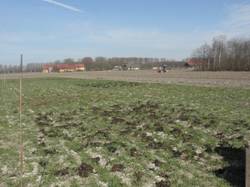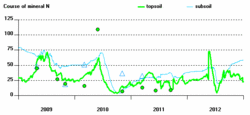Contact
Ir. Geert-Jan van der Burgt
Louis Bolk Institute (LBI)
Hoofdstraat 24
3972 LA Driebergen
The Netherlands
Tel. +31(0)343 523.860
Fax +31(0)343 515.611
g.vanderburgt(at)louisbolk.nl
www.louisbolk.org
The Dutch Mac and the Broekemahoeve trial and their role in the TILMAN-ORG project
The TILMAN-ORG workpackage "Improved nutrient management in reduced tillage systems by use of green manures and appropriate off-farm inputs" aims at a more rational use of green manures and off-farm inputs in reduced tillage systems to optimise nitrogen utilisation.
Experimental field in spring during the spreading of the organic fertilizers. Photo: Petra Rietberg / LB. Course of inorganic nitrogen (nitrate-N) during four years in the ploughed plots of the BASIS trial (average of four plots). Green line: simulated level in topsoil 0-30 cm. Blue line: simulated level in subsoil 30-60 cm. Green dots: measured levels in topsoil. Blue triangles: measured levels in subsoil. Y-axis: kg N ha-1.
Experimental field in spring during the spreading of the organic fertilizers. Photo: Petra Rietberg / LB. Course of inorganic nitrogen (nitrate-N) during four years in the ploughed plots of the BASIS trial (average of four plots). Green line: simulated level in topsoil 0-30 cm. Blue line: simulated level in subsoil 30-60 cm. Green dots: measured levels in topsoil. Blue triangles: measured levels in subsoil. Y-axis: kg N ha-1.
Two existing Durch experiments, which are described below, are used for trials on the incorporation of green manures, fodder legume crops, carbon rich composted off-farm inputs, and on- or off-farm produced N-rich plant residues. This way their effect on N dynamics in subsequent crops in reduced tillage systems will be assessed.
The MAC trial
The Dutch long-term soil fertility trial "Manure As Chance" (MAC trial) started in 1999 with 13 different fertilizer strategies in four replications. Artificial fertilizer is compared with manure and compost treatments. In autumn 2011 the use of catch crops is introduced in the system. For the TILMAN-ORG project, data will be delivered related to the nitrogen dynamics of soil organic matter and the quantitative impact of catch crops in cropping systems.
The nitrogen in organic fertilizers does not fully mineralize within a season, and hence will partly become available in later years. This effect is taken into account for the first year but generally not in later fertilizer applications. If mineralization from reserves of organic fertilizers from previous years was taken into account, mineral fertilizer use could be reduced.
This study is an analysis of a 13-year field trial where crop yield was measured in 13 fertilizer treatments which differ in total N applied and decomposition rate. This is complemented with a model study in which mineralization and soil nitrogen content were calculated.
We intended to show step by step that the use of fertilizers with a low decomposition rate lead over the years to an increase in soil organic nitrogen, with increased nitrogen mineralization and availability, and that this results in increased yields, compared to fertilizers with a high decomposition rate. When using, deep stable manure for example, we show that after some years more than 50% of the available nitrogen in a season is derived from manure applied in former years.
This makes clear that, at least in agricultural systems that use a substantial amount of organic fertilizers, it is worthwhile taking this delayed mineralization into account.
The results up to 2011 are presented and discussed in the report by Opheusden et al. (2012).
Broekemahoeve trial, the Netherlands
At the Broekema farm, a long-term trial "BASIS" (Broekemahoeve Applied Soil Innovation Systems) started in 2009. Conventional tillage (ploughing) is compared with reduced tillage and minimal tillage under conventional and organic farming practice. The nitrogen dynamics are studied, using the nitrogen and organic matter model NDICEA (www.ndicea.nl). In the TILMAN-ORG project, the NDICEA model is used to stimulate the effect of tillage systems and nutrient management (including green manure and fertilization treatments) on N cycling and carbon pools.
Except for one measurement in 2010, the match between simulated and measured soil mineral N levels is good (see graph, average data from four ploughed plots). Differences in yield between ploughed and reduced tillage are very small for cereals, sugar beets and potatoes. In carrots and onions the reduced tillage treatment has lower yields. The nitrogen dynamics so far do not show substantial differences, although soil organic matter is, after four years of not ploughing, more concentrated in the upper 15 cm. If there is a difference in soil available nitrogen, it is lower in the reduced tillage plots than in the ploughed plots.
More information
Author
Geert-Jan van der Burgt, Louis Bolk Instituut, The Netherlands.
Quote
A.H.M. van Opheusden, G.J.H.M. van der Burgt and P.I. Rietberg (2012): Decomposition rate of organic fertilizers: effect on yield, nitrogen availability and nitrogen stock in the soil. Louis Bolk Institute, Direberger. Available at http://www.louisbolk.org/downloads/2666.pdf
Links
- TILMAN-ORG.net: Work package 5
 This website was archived on January 11, 2020 and is no longer updated.
This website was archived on January 11, 2020 and is no longer updated.


